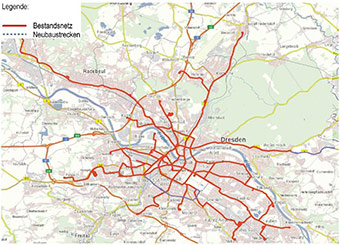The project is modernising the tram fleet in Dresden, Germany with the purchase of 21 unidirectional and nine bidirectional 45-m-long, 300-seat vehicles. Of these 30 new trams, 28 will replace existing vehicles, while the other two will expand the fleet.
Tram fleet in Dresden, Germany to be modernised and expanded
- 28 October 2019
Since the 1990s, Dresden’s tramlines have gradually been widened to 3 m and will thus be able to accommodate the new trams, which have a width of 2.65 m – compared with 2.3 m for those they replace. As a result, the total seating capacity of the fleet will be increased by 4 240.
Rising demand for mobility
As the capital of the state of Saxony, Dresden is an important regional centre characterised by dynamic development and high population growth. Forecasts envisage an increase from the current 550 000 inhabitants to 587 900 by 2030, and a further increase to 595 000 by 2040. On the one hand, this is due to a steady inflow of people and on the other, to a high birth rate, with children between six and 17 set to be the largest age group in 2030.
In 2016, Dresden’s trams were used for some 157.1 million journeys, up 18.6 million from 2005. This figure is expected to rise by a further 19.5 million by 2023. The share of public transport in terms of total distance travelled within the urban area also rose – from 20 % in 2003 to 22 % in 2013. A shift towards more flexible mobility has been particularly noticeable among younger people.
Dresden’s tramways are working at full capacity during peak hours and the quality of service on the most frequently used routes is now inadequate. Moreover, an increase in numbers of students and young adults will require extra capacity for student transport, which is already used heavily. In addition, changes in mobility behaviour, demographics and accessibility needs will have an impact on seating requirements due to the increasing proportion of passengers with pushchairs, wheelchairs or bicycles.
At the same time, Dresden is faced with meeting this rising demand for mobility in an environmentally sustainable manner. Its VEP 2025plus transport development plan is focused on boosting public transport use, while the city has taken other measures aimed at reconciling urban mobility and environmental protection, including its 2011 clean air plan and integrated energy and climate protection concept, and its 2008 noise reduction plan.
Higher capacity, lower emissions
The objectives of the current project are to reduce CO2 emissions from transport in Dresden and increase public transport capacity and attractiveness, as well as improving performance. The introduction of the new vehicles – which use an efficient electric drive system – should help achieve this.
At present, the tram fleet comprises 172 vehicles – rising to 174 following implementation of the project. Of these, 100 are 30 m long and 72 are either 42 m or 45 m long. Under the project, 28 of the 30 m-long trams – which have 170 seats – will be taken out of service and replaced by the 300-seat vehicles. The coach body width of the new trams will be 2.65 m, but due to the configuration of the platforms on the network, their floors will only be 2.30 wide.
Total investment and EU funding
Total investment for the project “Light rail vehicles - DVB Dresden” is EUR 163 149 000, with the EU’s European Regional Development Fund contributing EUR 102 825 000 through the “Sachsen” Operational Programme for the 2014-2020 programming period. The investment falls under the priority “Low-carbon economy”.

